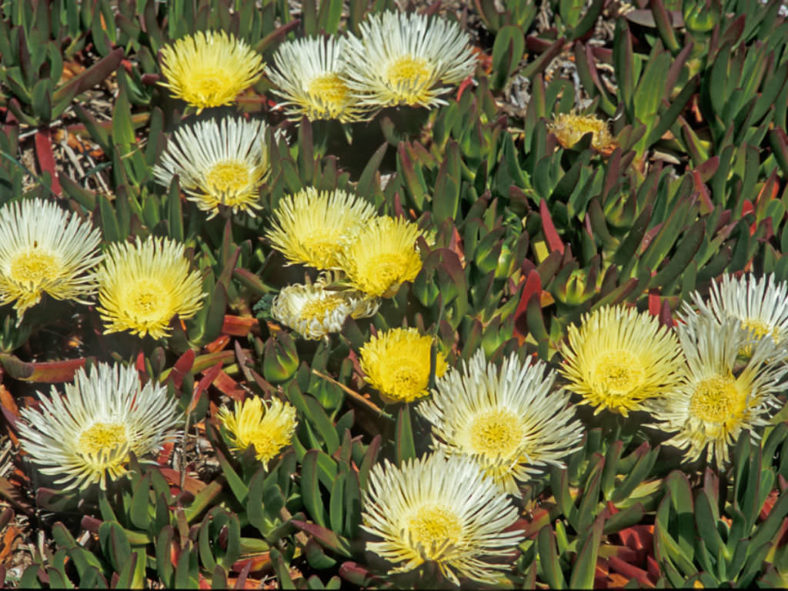Scientific Name
Carpobrotus edulis (L.) N. E. Br.
Common Name(s)
Hottentot Fig, Ice Plant, Highway Ice Plant, Freeway Ice Plant, Pigface, Sour Fig, Sea Fig, Cape Fig
Synonym(s)
Mesembryanthemum edule
Scientific Classification
Family: Aizoaceae
Subfamily: Ruschioideae
Tribe: Ruschieae
Genus: Carpobrotus
Etymology
The specific epithet "edulis" (pronounced "ED-yew-liss") means "edible" and refers to the edible fruits of this species.
Origin
Carpobrotus edulis is native to South Africa (Coastal and inland slopes from Namaqualand in the Northern Cape through the Western Cape to the Eastern Cape).
Description
Carpobrotus edulis is a mat-forming succulent with creeping stems, thick, fleshy, 3-angled leaves, and yellow or light pink flowers. It is easily confused with its close relatives but can be distinguished from most of them by the size and color of its daisy-like flowers, which can reach a diameter of 6 inches (15 cm). The leaves are crowded along the stem, ranging from yellowish to grass-green, becoming reddish with age. They are triangular in cross-section, measuring up to 5.2 inches (13 cm) long and 0.5 inches (1.3 cm) thick. The edible fruits are fleshy, yellow, fragrant when ripe, and can grow up to 1.4 inches (3.5 cm) in diameter.
The word "Hottentot" in the common name was first recorded in the late 17th century. It was used to refer to the Khoikhoi, a group of Khoisan-speaking pastoral peoples of South Africa and Namibia. Now, it is regarded as too derogatory and offensive to be used in an ethnic sense. The only acceptable modern use for "Hottentot" is in the common names of plants and animals.

Hardiness
USDA hardiness zones 8b to 11b: from 25°F (-3.9°C) to 50°F (10°C).
How to Grow and Care
Carpobrotus plants are notoriously unfussy. As long as their soil drains well, the soil is allowed to dry out between watering, and the plant receives pinching or pruning to keep it in shape, so little more must be done.
The only serious health threats to the plant are spittlebugs and some root and stem rots. You can avoid the rot by minimizing overhead watering when the plant will not dry off before nightfall. The bugs will remove themselves if you spray them with horticultural soap.
Growing Carpobrotus in containers is ideal; you can overwinter it in temperate regions. Just bring the pot in and water it deeply. Cut back the plant, let it dry out, and languish for the winter in a warm location. In spring, resume regular watering and move the plant to a full light situation with some protection from burning rays. Gradually reintroduce the plant to temperatures outdoors until it can tolerate a full day outside.
Learn more at How to Grow and Care for Carpobrotus.
Links
- Back to genus Carpobrotus
- Succupedia: Browse succulents by Scientific Name, Common Name, Genus, Family, USDA Hardiness Zone, Origin, or cacti by Genus
Photo Gallery
Click on a photo to see a larger version.


